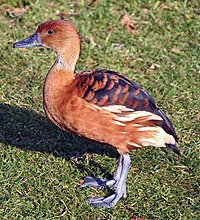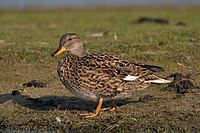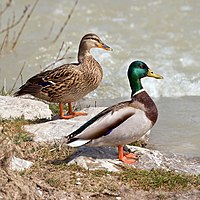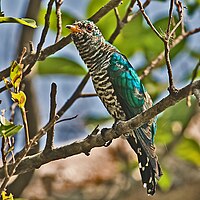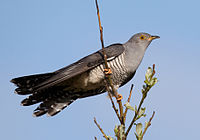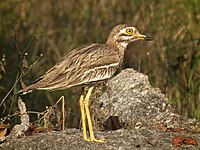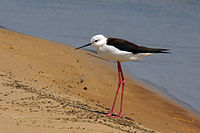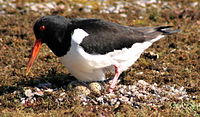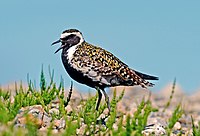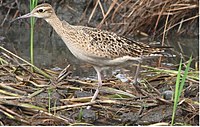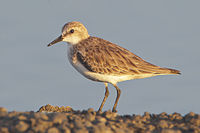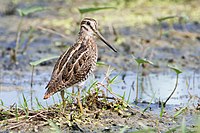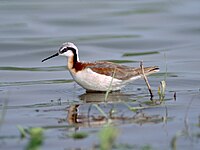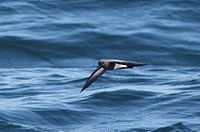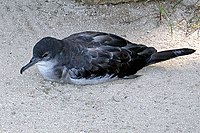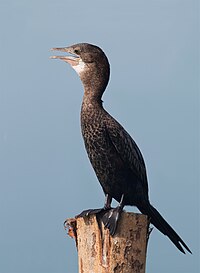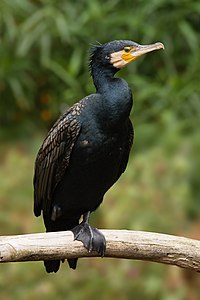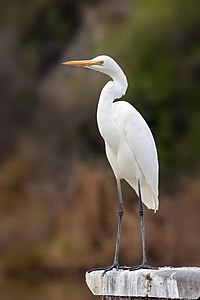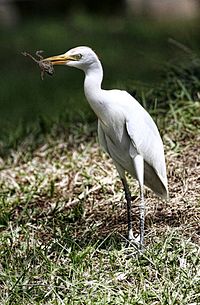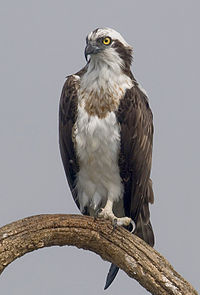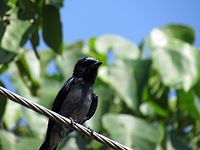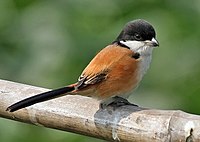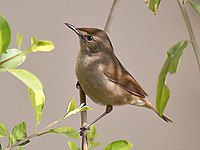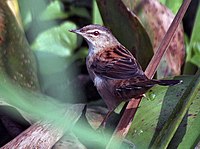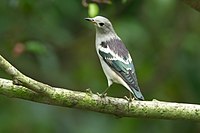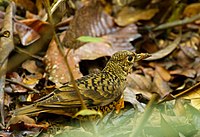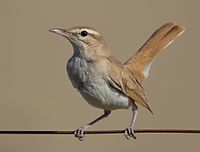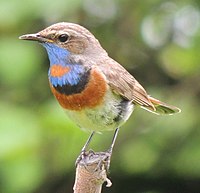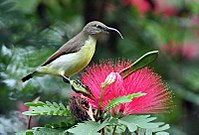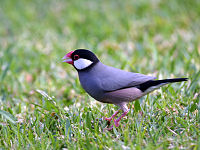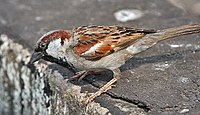List of birds of Sri Lanka
| Part of a series on |
| Wildlife of Sri Lanka |
|---|
 |
Sri Lanka is a tropical island situated close to the southern tip of India. The bird life of Sri Lanka is very rich for its size and 521 species have been recorded. In addition to the many resident birds, a considerable number of migratory species winter in the country to escape their northern breeding grounds.
34 species are confirmed as endemic.[1] The other resident species are also found in the nearby Indian mainland, but over 80 have developed distinct Sri Lankan races. Some of these races are very different in their plumage characteristics from the related forms in India. 26 species are globally threatened.
Bird distribution in Sri Lanka is largely determined by its climatic zones. The dry zone is largest of the three, covering more than half of the island, with a prolonged dry and hot period and only one monsoon (the north east monsoon from October to January).
The wet zone, with two monsoons, is in the south western quarter of the island, where the few remaining rain forests are found and humidity is high.
The central hill zone rises to over 2450 m (8-10,000 ft) and has a cool temperate climate. Most of the 34 endemic species are confined to the wet and the hill zones, with only a few extending into the dry zone as well.
Recent updates and sighting information can be obtained through the Field Ornithology Group of Sri Lanka website. The following list is prepared according to An Illustrated Guide to the Birds of Sri Lanka on 2010 by Sarath Kotagama and Gamini Ratnavira. Supplemental updates follow The Clements Checklist of Birds of the World, 2021 edition.[2][3]
The following tags have been used to highlight several categories. The commonly occurring native species do not fall into any of these categories.
- (A) Accidental - a species that rarely or accidentally occurs in Sri Lanka
- (E) Endemic - a species native or restricted to Sri Lanka
- (I) Introduced - a species introduced to Sri Lanka as a consequence, direct or indirect, of human actions
Ducks, geese, and waterfowl[]
Order: Anseriformes Family: Anatidae
The family Anatidae includes the ducks and most duck-like waterfowl, such as geese and swans. These birds are adapted to an aquatic existence with webbed feet, flattened bills, and feathers that are excellent at shedding water due to an oily coating.[4]
| Name | Binomial | Subspecies | Status | IUCN |
|---|---|---|---|---|
| Fulvous whistling-duck
|
Dendrocygna bicolor | Least concern (A) | ||
| Lesser whistling-duck
|
Dendrocygna javanica | Resident | Least concern | |
| Bar-headed goose
|
Anser indicus | Least concern (A) | ||
| Graylag goose
|
Anser anser | Anser anser rubrirostris | Least concern (A) | |
| Knob-billed duck
|
Sarkidiornis melanotos | Least concern (A) | ||
| Ruddy shelduck
|
Tadorna ferruginea | Least concern (A) | ||
| Cotton pygmy-goose
|
Nettapus coromandelianus | Resident | Least concern | |
| Garganey
|
Spatula querquedula | Least concern | ||
| Northern shoveler
|
Spatula clypeata | Least concern | ||
| Gadwall
|
Mareca strepera | Mareca strepera strepera | Least concern (A) | |
| Eurasian wigeon
|
Mareca penelope | Least concern | ||
| Indian spot-billed duck
|
Anas poecilorhyncha | Anas poecilorhyncha poecilorhyncha | Least concern | |
| Mallard
|
Anas platyrhynchos | Anas platyrhynchos platyrhynchos | Least concern (A) | |
| Northern pintail
|
Anas acuta | Least concern | ||
| Green-winged teal
|
Anas crecca | Least concern | ||
| Marbled teal
|
Marmaronetta angustirostris | Vulnerable (A) | ||
| Red-crested pochard
|
Netta rufina | Least concern (A) | ||
| Common pochard
|
Aythya ferina | Vulnerable (A) | ||
| Tufted duck
|
Aythya fuligula | Least concern (A) |
Pheasants, grouse, and allies[]
Order: Galliformes Family: Phasianidae
The Phasianidae are a family of terrestrial birds. In general, they are plump and have broad, relatively short wings.
| Name | Binomial | Subspecies | Status | IUCN |
|---|---|---|---|---|
| Indian peafowl
|
Pavo cristatus | Pavo cristatus singhalensis | Resident | Least concern |
| Sri Lanka spurfowl
|
Galloperdix bicalcarata | Endemic | Least concern | |
| Blue-breasted quail
|
Coturnix chinensis | Coturnix chinensis chinensis | Least concern | |
| Common quail
|
Coturnix coturnix | Least concern (A) | ||
| Rain quail
|
Coturnix coromandelica | Francolinus pondicerianus pondicerianus | Least concern (A) | |
| Jungle bush-quail
|
Perdicula asiatica | Least concern | ||
| Painted francolin
|
Francolinus pictus | Least concern | ||
| Gray francolin
|
Ortygornis pondicerianus | Ortygornis pondicerianus pondicerianus | Least concern | |
| Sri Lanka junglefowl
|
Gallus lafayettii | Endemic | Least concern |
Flamingos[]
Order: Phoenicopteriformes Family: Phoenicopteridae
Flamingos are gregarious wading birds, usually 3 to 5 feet (0.9 to 1.5 m) tall, found in both the Western and Eastern Hemispheres. Flamingos filter-feed on shellfish and algae. Their oddly shaped beaks are specially adapted to separate mud and silt from the food they consume and, uniquely, are used upside-down.
| Name | Binomial | Subspecies | Status | IUCN |
|---|---|---|---|---|
| Greater flamingo
|
Phoenicopterus ruber | Least concern | ||
| Lesser flamingo
|
Phoenicopterus minor | Near threatened (A) |
Grebes[]
Order: Podicipediformes Family: Podicipedidae
Grebes are small to medium-sized diving birds. They breed on fresh water, but often visit the sea whilst migrating and in winter. They have lobed toes and are excellent swimmers and divers; however, their feet are placed far back on their bodies, making them quite ungainly on land.
| Name | Binomial | Subspecies | Status | IUCN |
|---|---|---|---|---|
| Little grebe
|
Tachybaptus ruficollis | Tachybaptus ruficollis capensis | Resident | Least concern |
Pigeons and doves[]
Order: Columbiformes Family: Columbidae
Pigeons and doves are stout-bodied birds with short necks and short slender bills with a fleshy cere.
| Name | Binomial | Subspecies | Status | IUCN |
|---|---|---|---|---|
| Rock pigeon
|
Columba livia | Columba livia intermedia | Resident | Least concern |
| Sri Lanka wood-pigeon
|
Columba torringtoniae | Endemic | Vulnerable | |
| Pale-capped pigeon
|
Columba punicea | Vulnerable (A) | ||
| Oriental turtle-dove
|
Streptopelia orientalis | Least concern | ||
| Eurasian collared-dove
|
Streptopelia decaocto | Streptopelia decaocto intercedens | Least concern | |
| Red collared-dove
|
Streptopelia tranquebarica | Least concern (A) | ||
| Spotted dove
|
Spilopelia chinensis | Spilopelia chinensis ceylonensis | Least concern | |
| Asian emerald dove
|
Chalcophaps indica | Chalcophaps indica robinsoni | Least concern | |
| Orange-breasted green-pigeon
|
Treron bicincta | Treron bicincta leggei | Least concern | |
| Sri Lanka green-pigeon
|
Treron pompadora | Endemic | Least concern | |
| Yellow-footed green-pigeon
|
Treron phoenicoptera | Least concern | ||
| Green imperial-pigeon
|
Ducula aenea | Least concern |
Cuckoos[]
Order: Cuculiformes Family: Cuculidae
The family Cuculidae includes cuckoos, roadrunners and anis. These birds are of variable size with slender bodies, long tails and strong legs. Many are brood parasites.
| Name | Binomial | Subspecies | Status | IUCN |
|---|---|---|---|---|
| Green-billed coucal
|
Centropus chlororhynchus | Endemic | Vulnerable | |
| Greater coucal
|
Centropus sinensis | Least concern (A) | ||
| Lesser coucal
|
Centropus bengalensis | Least concern (A) | ||
| Sirkeer malkoha
|
Taccocua leschenaultii | Least concern | ||
| Red-faced malkoha
|
Phaenicophaeus pyffhocephalus | Endemic | Vulnerable | |
| Blue-faced malkoha
|
Phaenicophaeus viridirostris | Least concern | ||
| Chestnut-winged cuckoo
|
Clamator coromandus | Least concern | ||
| Pied cuckoo
|
Clamator jacobinus | Clamator jacobinus jacobinus | Least concern | |
| Asian koel
|
Eudynamys scolopacea | Eudynamys scolopacea scolopacea | Least concern | |
| Asian emerald cuckoo
|
Chrysococcyx maculatus | Least concern (A) | ||
| Banded bay cuckoo
|
Cacomantis sonneratii | Cacomantis sonneratii waiti | Least concern | |
| Gray-bellied cuckoo
|
Cacomantis passerinus | Least concern | ||
| Fork-tailed drongo-cuckoo
|
Surniculus dicruroides | Least concern | ||
| Common hawk-cuckoo
|
Hierococcyx varius | Least concern | ||
| Lesser cuckoo
|
Cuculus poliocephalus | Least concern | ||
| Indian cuckoo
|
Cuculus micropterus | Least concern | ||
| Common cuckoo
|
Cuculus canorus | Cuculus canorus bakeri | Least concern |
Frogmouths[]
Order: Caprimulgiformes Family: Podargidae
The frogmouths are a group of nocturnal birds related to the nightjars. They are named for their large flattened hooked bill and huge frog-like gape, which they use to take insects.
| Name | Binomial | Subspecies | Status | IUCN |
|---|---|---|---|---|
| Sri Lanka frogmouth
|
Batrachostomus moniliger | Resident | Least concern |
Nightjars and allies[]
Order: Caprimulgiformes Family: Caprimulgidae
Nightjars are medium-sized nocturnal birds that usually nest on the ground. They have long wings, short legs and very short bills. Most have small feet, of little use for walking, and long pointed wings. Their soft plumage is camouflaged to resemble bark or leaves.
| Name | Binomial | Subspecies | Status | IUCN |
|---|---|---|---|---|
| Great eared-nightjar
|
Lyncornis macrotis | Least concern (A) | ||
| Jungle nightjar
|
Caprimulgus indicus | Caprimulgus indicus kelaarti | Resident | Least concern |
| Jerdon's nightjar
|
Caprimulgus atripennis | Caprimulgus atripennis aequabilis | Resident | Least concern |
| Indian nightjar
|
Caprimulgus asiaticus | Resident | Least concern |
Swifts[]
Order: Apodiformes/Caprimulgiformes Family: Apodidae
Swifts are small birds which spend the majority of their lives flying. These birds have very short legs and never settle voluntarily on the ground, perching instead only on vertical surfaces. Many swifts have long swept-back wings which resemble a crescent or boomerang.
| Name | Binomial | Subspecies | Status | IUCN |
|---|---|---|---|---|
| White-throated needletail
|
Hirundapus caudacutus | Least concern (A) | ||
| Brown-backed needletail
|
Hirundapus giganteus | Least concern | ||
| Indian swiftlet
|
Aerodramus unicolor | Least concern | ||
| Himalayan swiftlet | Aerodramus brevirostris | Least concern (A) | ||
| Alpine swift
|
Apus melba | Least concern | ||
| Common swift
|
Apus apus | Least concern (A) | ||
| Pallid swift
|
Apus pallidus | Least concern (A) | ||
| Blyth's swift | Apus leuconyx | Least concern (A) | ||
| Dark-rumped swift | Apus acuticauda | Vulnerable (A) | ||
| Little swift
|
Apus affinis | Least concern | ||
| Asian palm-swift
|
Cypsiurus balasiensis | Least concern |
Treeswifts[]
Order: Apodiformes/Caprimulgiformes Family: Hemiprocnidae
The treeswifts, or crested swifts, are closely related to the true swifts. They differ from the other swifts in that they have crests, long forked tails and softer plumage.
| Name | Binomial | Subspecies | Status | IUCN |
|---|---|---|---|---|
| Crested treeswift
|
Hemiprocne coronata | Resident | Least concern |
Rails, gallinules, and coots[]
Order: Gruiformes Family: Rallidae
Rallidae is a large family of small to medium-sized birds which includes the rails, crakes, coots and gallinules. Typically they inhabit dense vegetation in damp environments near lakes, swamps or rivers. In general they are shy and secretive birds, making them difficult to observe. Most species have strong legs and long toes which are well adapted to soft uneven surfaces. They tend to have short, rounded wings and to be weak fliers.
| Name | Binomial | Subspecies | Status | IUCN |
|---|---|---|---|---|
| Water rail
|
Rallus aquaticus | Rallus aquaticus korejewi | Least concern (A) | |
| Brown-cheeked rail
|
Rallus indicus | Least concern (A) | ||
| Corn crake
|
Crex crex | Least concern (A) | ||
| Slaty-breasted rail
|
Lewinia striata | Least concern | ||
| Eurasian moorhen
|
Gallinula chloropus | Eurasian common moorhen Gallinula chloropus chloropus | Least concern | |
| Eurasian coot
|
Fulica atra | Least concern | ||
| Gray-headed swamphen
|
Porphyrio poliocephalus | Least concern | ||
| Watercock
|
Gallicrex cinerea | Least concern | ||
| White-breasted waterhen
|
Amaurornis phoenicurus | Amaurornis phoenicurus phoenicurus | Least concern | |
| Slaty-legged crake
|
Rallina eurizonoides | Least concern | ||
| Ruddy-breasted crake
|
Zapornia fusca | Least concern | ||
| Baillon's crake
|
Zapornia pusilla | Least concern |
Thick-knees[]
Order: Charadriiformes Family: Burhinidae
Thick-knees are a group of largely tropical waders in the family Burhinidae. They are found worldwide within the tropical zone, with some species also breeding in temperate Europe and Australia. They are medium to large waders with strong black or yellow-black bills, large yellow eyes and cryptic plumage. Despite being classed as waders, most species have a preference for arid or semi-arid habitats.
| Name | Binomial | Subspecies | Status | IUCN |
|---|---|---|---|---|
| Indian thick-knee
|
Burhinus indicus | Resident | Least concern | |
| Great thick-knee
|
Esacus recurvirostris | Resident | Least concern |
Stilts and avocets[]
Order: Charadriiformes Family: Recurvirostridae
Recurvirostridae is a family of large wading birds, which includes the avocets and stilts. The avocets have long legs and long up-curved bills. The stilts have extremely long legs and long, thin, straight bills.
| Name | Binomial | Subspecies | Status | IUCN |
|---|---|---|---|---|
| Black-winged stilt
|
Himantopus himantopus | Himantopus himantopus meridionalis | Resident | Least concern |
| Pied stilt
|
Himantopus leucocephalus | Least concern | ||
| Pied avocet
|
Recurvirostra avosetta | Resident | Least concern |
Oystercatchers[]
Order: Charadriiformes Family: Haematopodidae
The oystercatchers are large and noisy plover-like birds, with strong bills used for smashing or prising open molluscs.
| Name | Binomial | Subspecies | Status | IUCN |
|---|---|---|---|---|
| Eurasian oystercatcher
|
Haematopus ostralegus | Near threatened |
Plovers and lapwings[]
Order: Charadriiformes Family: Charadriidae
The family Charadriidae includes the plovers, dotterels and lapwings. They are small to medium-sized birds with compact bodies, short, thick necks and long, usually pointed, wings. They are found in open country worldwide, mostly in habitats near water.
| Name | Binomial | Subspecies | Status | IUCN |
|---|---|---|---|---|
| Black-bellied plover
|
Pluvialis squatarola | Least concern | ||
| Pacific golden-plover
|
Pluvialis fulva | Least concern | ||
| Yellow-wattled lapwing
|
Vanellus malabaricus | Least concern | ||
| Gray-headed lapwing
|
Vanellus cinereus | Least concern (A) | ||
| Red-wattled lapwing
|
Vanellus indicus | Vanellus indicus lankae | Least concern | |
| Sociable lapwing
|
Chettusia gregarius | Critically endangered (A) | ||
| Lesser sand-plover
|
Charadrius mongolus | Least concern | ||
| Greater sand-plover
|
Charadrius leschenaultii | Least concern | ||
| Caspian plover
|
Charadrius asiaticus | Least concern (A) | ||
| Kentish plover
|
Charadrius alexandrinus | Least concern | ||
| Common ringed plover
|
Charadrius hiaticula | Charadrius hiaticula tundrae | Least concern | |
| Long-billed plover
|
Charadrius placidus | Least concern (A) | ||
| Little ringed plover
|
Charadrius dubius | Least concern | ||
| Oriental plover
|
Charadrius veredus | Least concern (A) |
Painted-snipes[]
Order: Charadriiformes Family: Rostratulidae
Painted-snipes are short-legged, long-billed birds similar in shape to the true snipes, but more brightly coloured.
| Name | Binomial | Subspecies | Status | IUCN |
|---|---|---|---|---|
| Greater painted-snipe
|
Rostratula benghalensis | Least concern |
Jacanas[]
Order: Charadriiformes Family: Jacanidae
The jacanas are a group of tropical waders in the family Jacanidae. They are found throughout the tropics. They are identifiable by their huge feet and claws which enable them to walk on floating vegetation in the shallow lakes that are their preferred habitat.
| Name | Binomial | Subspecies | Status | IUCN |
|---|---|---|---|---|
| Pheasant-tailed jacana
|
Hydrophasianus chirurgus | Least concern |
Sandpipers and allies[]
Order: Charadriiformes Family: Scolopacidae
Scolopacidae is a large diverse family of small to medium-sized shorebirds including the sandpipers, curlews, godwits, shanks, tattlers, woodcocks, snipes, dowitchers and phalaropes. The majority of these species eat small invertebrates picked out of the mud or soil. Variation in length of legs and bills enables multiple species to feed in the same habitat, particularly on the coast, without direct competition for food.
| Name | Binomial | Subspecies | Status | IUCN |
|---|---|---|---|---|
| Whimbrel
|
Numenius phaeopus | Least Concern | ||
| Little curlew
|
Numenius minutus | Least Concern (A) | ||
| Slender-billed curlew
|
Numenius tenuirostris | Critically Endangered (A) | ||
| Eurasian curlew
|
Numenius arquata | Near Threatened | ||
| Bar-tailed godwit
|
Limosa lapponica | Near Threatened | ||
| Black-tailed godwit
|
Limosa limosa | Near Threatened | ||
| Ruddy turnstone
|
Arenaria interpres | Least Concern | ||
| Great knot
|
Calidris tenuirostris | Endangered | ||
| Red knot
|
Calidris canutus | Near Threatened | ||
| Ruff
|
Calidris pugnax | Least Concern | ||
| Broad-billed sandpiper
|
Calidris falcinellus | Least Concern | ||
| Sharp-tailed sandpiper
|
Calidris acuminata | Least Concern (A) | ||
| Curlew sandpiper
|
Calidris ferruginea | Near Threatened | ||
| Temminck's stint
|
Calidris temminckii | Least Concern | ||
| Long-toed stint
|
Calidris subminuta | Least Concern | ||
| Spoon-billed sandpiper
|
Calidris pygmeus | Critically Endangered (A) | ||
| Red-necked stint
|
Calidris ruficollis | Near Threatened (A) | ||
| Sanderling
|
Calidris alba | Least Concern | ||
| Dunlin
|
Calidris alpina | Least Concern (A) | ||
| Little stint
|
Calidris minuta | Least Concern | ||
| White-rumped sandpiper
|
Calidris fuscicollis | Least Concern (A) | ||
| Buff-breasted sandpiper
|
Calidris subruficollis | Near Threatened (A) | ||
| Pectoral sandpiper
|
Calidris melanotos | Least Concern (A) | ||
| Asian dowitcher
|
Limnodramus semipalmatus | Near Threatened (A) | ||
| Jack snipe
|
Lymnocryptes minimus | Least Concern (A) | ||
| Eurasian woodcock
|
Scolopax rusticola | Least Concern | ||
| Wood snipe
|
Gallinago nemoricola | Vulnerable (A) | ||
| Great snipe
|
Gallinago media | Near Threatened (A) | ||
| Common snipe
|
Gallinago gallinago | Least Concern | ||
| Pin-tailed snipe
|
Gallinago stenura | Least Concern | ||
| Swinhoe's snipe
|
Gallinago megala | Least Concern (A) | ||
| Terek sandpiper
|
Xenus cinereus | Least Concern | ||
| Wilson's phalarope
|
Phalaropus tricolor | Least Concern (A) | ||
| Red-necked phalarope
|
Phalaropus lobatus | Least Concern | ||
| Red phalarope
|
Phalaropus fulicarius | Least Concern (A) | ||
| Common sandpiper
|
Actitis hypoleucos | Least Concern | ||
| Spotted sandpiper
|
Actitis macularius | Least Concern (A) | ||
| Green sandpiper
|
Tringa ochropus | Least Concern | ||
| Solitary sandpiper
|
Tringa solitaria | Least Concern (A) | ||
| Spotted redshank
|
Tringa erythropus | Least Concern (A) | ||
| Common greenshank
|
Tringa nebularia | Least Concern | ||
| Nordmann's greenshank
|
Tringa guttifer | Endangered (A) | ||
| Marsh sandpiper
|
Tringa stagnatilis | Least Concern | ||
| Wood sandpiper
|
Tringa glareola | Least Concern | ||
| Common redshank
|
Tringa totanus | Least Concern |
Buttonquail[]
Order: Charadriiformes Family: Turnicidae
The buttonquail are small, drab, running birds which resemble the true quails. The female is the brighter of the sexes and initiates courtship.
| Name | Binomial | Subspecies | Status | IUCN |
|---|---|---|---|---|
| Small buttonquail
|
Turnix sylvaticus | Least concern (A) | ||
| Barred buttonquail
|
Turnix sylvatica | Least concern |
Crab-plover[]
Order: Charadriiformes Family: Dromadidae
The crab-plover is related to the waders. It resembles a plover but with very long grey legs and a strong heavy black bill similar to a tern. It has black-and-white plumage, a long neck, partially webbed feet and a bill designed for eating crabs.
| Name | Binomial | Subspecies | Status | IUCN |
|---|---|---|---|---|
| Crab-plover
|
Dromas ardeola | Least concern |
Pratincoles and coursers[]
Order: Charadriiformes Family: Glareolidae
Glareolidae is a family of wading birds comprising the pratincoles, which have short legs, long pointed wings and long forked tails, and the coursers, which have long legs, short wings and long, pointed bills which curve downwards.
| Name | Binomial | Subspecies | Status | IUCN |
|---|---|---|---|---|
| Indian courser
|
Cursorius coromandelicus | Least concern | ||
| Collared pratincole
|
Glareola pratincola | Least concern | ||
| Oriental pratincole
|
Glareola maldivarum | Least concern | ||
| Small pratincole
|
Glareola lactea | Least concern |
Skuas and jaegers[]
Order: Charadriiformes Family: Stercorariidae
The family Stercorariidae are, in general, medium to large birds, typically with grey or brown plumage, often with white markings on the wings. They nest on the ground in temperate and arctic regions and are long-distance migrants.
| Name | Binomial | Subspecies | Status | IUCN |
|---|---|---|---|---|
| South polar skua
|
Catharacta maccormicki | Least concern (A) | ||
| Brown skua
|
Catharacta antarctica | Least concern | ||
| Pomarine jaeger
|
Stercorarius pomarinus | Least concern | ||
| Parasitic jaeger
|
Stercorarius parasiticus | Least concern (A) | ||
| Long-tailed jaeger
|
Stercorarius longicaudus | Least concern (A) |
Gulls, terns, and skimmers[]

Order: Charadriiformes Family: Laridae
Laridae is a family of medium to large seabirds, the gulls and terns. Gulls are typically grey or white, often with black markings on the head or wings. They have stout, longish bills and webbed feet. Terns are a group of generally medium to large seabirds typically with grey or white plumage, often with black markings on the head. Most terns hunt fish by diving but some pick insects off the surface of fresh water. Terns are generally long-lived birds, with several species known to live in excess of 30 years.
- Slender-billed gull, Chroicocephalus genei (A)
- Black-headed gull, Chroicocephalus ridibundus
- Brown-headed gull, Chroicocephalus brunnicephalus
- Sooty gull, Ichthyaetus hemprichii (A)
- Pallas's gull, Ichthyaetus ichthyaetus
- Herring gull, Larus argentatus
- Lesser black-backed gull, Larus fuscus
- Brown noddy, Anous stolidus
- Black noddy, Anous minutus (A)
- Lesser noddy, Anous tenuirostris
- Sooty tern, Onychoprion fuscatus
- Bridled tern, Onychoprion anaethetus
- Little tern, Sternula albifrons
- Saunders's tern, Sternula saundersi
- Gull-billed tern, Gelochelidon nilotica
- Caspian tern, Hydroprogne caspia
- Black tern, Chlidonias niger (A)
- White-winged tern, Chlidonias leucopterus
- Whiskered tern, Chlidonias hybrida
- Roseate tern, Sterna dougalli
- Black-naped tern, Sterna sumatrana (A)
- Common tern, Sterna hirundo
- White-cheeked tern, Sterna repressa (A)
- Great crested tern, Thalasseus bergii
- Sandwich tern, Thalasseus sandvicensis
- Lesser crested tern, Thalasseus bengalensis
- White tern, Gygis alba (A)
Tropicbirds[]
Order: Phaethontiformes Family: Phaethontidae
Tropicbirds are slender white birds of tropical oceans, with exceptionally long central tail feathers. Their heads and long wings have black markings.[5]
| Name | Binomial | Subspecies | Status | IUCN |
|---|---|---|---|---|
| White-tailed tropicbird
|
Phaethon lepturus | Phaethon lepturus lepturus | Least concern | |
| Red-billed tropicbird
|
Phaethon aethereus | Least concern |
Southern storm-petrels[]
Order: Procellariiformes Family: Oceanitidae
Southern storm-petrels are small birds which spend most of their lives at sea, coming ashore only to breed. They feed on planktonic crustaceans and small fish picked from the surface, typically while hovering or pattering across the water. Their flight is fluttering and sometimes bat-like.[6]
| Name | Binomial | Subspecies | Status | IUCN |
|---|---|---|---|---|
| Wilson's storm-petrel
|
Oceanites oceanicus | Least concern | ||
| White-faced storm-petrel
|
Pelagodroma marina | Least concern | ||
| Black-bellied storm-petrel
|
Fregetta tropica | Least concern (A) |
Northern storm-petrels[]
Order: Procellariiformes Family: Hydrobatidae
Northern storm-petrels are small birds which spend most of their lives at sea, coming ashore only to breed. They feed on planktonic crustaceans and small fish picked from the surface, typically while hovering or pattering across the water. Their flight is fluttering and sometimes bat-like.[6]
| Name | Binomial | Subspecies | Status | IUCN |
|---|---|---|---|---|
| Swinhoe's storm-petrel
|
Hydrobates monorhis | Near threatened (A) |
Shearwaters and petrels[]
Order: Procellariiformes Family: Procellariidae
The procellariids are the main group of medium-sized "true petrels", characterised by united nostrils with medium septum and a long outer functional primary.[6]
| Name | Binomial | Subspecies | Status | IUCN |
|---|---|---|---|---|
| Cape petrel
|
Daption capense | Daption capense capense | Migrant | Least concern (A) |
| Soft-plumaged petrel
|
Pterodroma mollis | Least concern (A) | ||
| Barau's petrel
|
Pterodroma baraui | Endangered (A) | ||
| White-headed petrel
|
Pterodroma lessonii | Least concern (A) | ||
| Bulwer's petrel
|
Bulweria bulwerii | Least concern (A) | ||
| Jouanin's petrel
|
Bulweria fallax | Near threatened (A) | ||
| Streaked shearwater
|
Calonectris leucomelas | Near threatened (A) | ||
| Flesh-footed shearwater
|
Ardenna cameipes | Near threatened | ||
| Wedge-tailed shearwater
|
Ardenna pacificus | Least concern | ||
| Sooty shearwater
|
Ardenna griseus | Near threatened (A) | ||
| Short-tailed shearwater
|
Ardenna tenuirostris | Least concern (A) | ||
| Tropical shearwater
|
Puffinus bailloni | Least concern (A) | ||
| Persian shearwater
|
Puffinus persicus | Least concern |
Storks[]
Order: Ciconiiformes Family: Ciconiidae
Storks are large, long-legged, long-necked, wading birds with long, stout bills. Storks are virtually mute, but bill-clattering is an important mode of communication at the nest. Their nests can be large and may be reused for many years. Many species are migratory.[7]
| Name | Binomial | Subspecies | Status | IUCN |
|---|---|---|---|---|
| Asian openbill
|
Anastomus oscitans | Resident | Least concern | |
| Black stork
|
Ciconia nigra | Least concern (A) | ||
| Woolly-necked stork
|
Ciconia episcopus | Ciconia episcopus episcopus | Resident | Vulnerable |
| White stork
|
Ciconia ciconia | Ciconia ciconia asiatica | Least concern (A) | |
| Black-necked stork
|
Ephippiorhynchus asiaticus | Ephippiorhynchus asiaticus asiaticus | Resident[8] | Near threatened |
| Lesser adjutant
|
Leptoptilos javanicus | Resident | Vulnerable | |
| Painted stork
|
Mycteria leucocephala | Resident | Near threatened |
Frigatebirds[]
Order: Suliformes Family: Fregatidae
Frigatebirds are large seabirds usually found over tropical oceans. They are large, black and white or completely black, with long wings and deeply forked tails. The males have coloured inflatable throat pouches. They do not swim or walk and cannot take off from a flat surface. Having the largest wingspan-to-body-weight ratio of any bird, they are essentially aerial, able to stay aloft for more than a week.[5] None are resident.
| Name | Binomial | Subspecies | Status | IUCN |
|---|---|---|---|---|
| Lesser frigatebird
|
Fregata ariel | Fregata ariel ariel | Least concern (A) | |
| Christmas Island frigatebird
|
Fregata andrewsi | Critically endangered (A) | ||
| Great frigatebird
|
Fregata minor | Fregata minor minor | Least concern (A) |
Boobies and gannets[]
Order: Suliformes Family: Sulidae
The gannets and boobies in the family Sulidae are medium to large coastal seabirds that plunge-dive for fish.[5]
| Name | Binomial | Subspecies | Status | IUCN |
|---|---|---|---|---|
| Masked booby
|
Sula dactylatra | Sula dactylatra melanops | Least concern | |
| Brown booby
|
Sula leucogaster | Sula leucogaster plotus | Least concern | |
| Red-footed booby
|
Sula sula | Sula sula rubripes | Least concern |
Anhingas[]
Order: Suliformes Family: Anhingidae
Anhingas or darters are often called "snake-birds" because they have long thin necks, which gives a snake-like appearance when they swim with their bodies submerged. The males have black and dark-brown plumage, an erectile crest on the nape, and a larger bill than the female. The females have much paler plumage, especially on the neck and underparts. The darters have completely webbed feet and their legs are short and set far back on the body. Their plumage is somewhat permeable, like that of cormorants, and they spread their wings to dry after diving.[5]
| Name | Binomial | Subspecies | Status | IUCN |
|---|---|---|---|---|
| Oriental darter
|
Anhinga melanogaster | Resident[9] | Near threatened |
Cormorants and shags[]
Order: Suliformes Family: Phalacrocoracidae
Phalacrocoracidae is a family of medium to large coastal, fish-eating seabirds that includes cormorants and shags. Plumage colouration varies; the majority of species have mainly dark plumage, but some are pied black and white, and a few are more colourful.[5]
| Name | Binomial | Subspecies | Status | IUCN |
|---|---|---|---|---|
| Little cormorant
|
Microcarbo niger | Resident | Least concern | |
| Great cormorant
|
Phalacrocorax carbo | Phalacrocorax carbo carbo | Resident | Least concern |
| Indian cormorant
|
Phalacrocorax fuscicollis | Resident | Least concern |
Pelicans[]
Order: Pelecaniformes Family: Pelecanidae
Pelicans are large water birds with a distinctive pouch under their beak. As with other members of the order Pelecaniformes, they have webbed feet with four toes.[5]
| Name | Binomial | Subspecies | Status | IUCN |
|---|---|---|---|---|
| Great white pelican
|
Pelecanus onocrotalus | Least concern (A) | ||
| Spot-billed pelican
|
Pelecanus philippensis | Resident.[10] | Near threatened | |
| Dalmatian pelican
|
Pelecanus crispus | Near threatened (A) |
Herons, egrets, and bitterns[]
Order: Pelecaniformes Family: Ardeidae
The family Ardeidae contains the bitterns, herons and egrets. Herons and egrets are medium to large wading birds with long necks and legs. Bitterns tend to be shorter necked and more wary. Unlike other long-necked birds such as storks, ibises and spoonbills, members of this family fly with their necks retracted.[7]
| Name | Binomial | Subspecies | Status | IUCN |
|---|---|---|---|---|
| Great bittern
|
Botaurus stellaris | Botaurus stellaris stellaris | Least concern (A) | |
| Yellow bittern
|
Ixobrychus sinensis | Resident | Least concern | |
| Schrenck's bittern
|
Ixobrychus eurhythmus | Least concern (A) | ||
| Cinnamon bittern
|
Ixobrychus cinnamomeus | Resident | Least concern | |
| Black bittern
|
Ixobrychus flavicollis | Resident | Least concern | |
| Gray heron
|
Ardea cinerea | Ardea cinerea cinerea | Resident | Least concern |
| Goliath heron
|
Ardea goliath | Least concern (A) | ||
| Purple heron
|
Ardea purpurea | Ardea purpurea manilensis | Resident | Least concern |
| Great egret
|
Ardea alba | Eastern great egret Ardea alba modesta |
Resident | Least concern |
| Intermediate egret
|
Ardea intermedia | Resident | Least concern | |
| Little egret
|
Egretta garzetta | Egretta garzetta garzetta | Resident | Least concern |
| Western reef-heron
|
Egretta gularis | Resident.[11] | Least concern | |
| Cattle egret
|
Bubulcus ibis | Bubulcus ibis coromandus | Resident | Least concern |
| Indian pond-heron
|
Ardeola grayii | Resident | Least concern | |
| Chinese pond-heron
|
Ardeola bacchus | Least concern (A) | ||
| Striated heron
|
Butorides striata | Resident | Least concern | |
| Black-crowned night-heron
|
Nycticorax nycticorax | Nycticorax nycticorax nycticorax | Resident | Least concern |
| Malayan night-heron
|
Gorsachius melanolophus | Least concern |
Ibises and spoonbills[]
Order: Pelecaniformes Family: Threskiornithidae
Threskiornithidae is a family of large terrestrial and wading birds which comprises the ibises and spoonbills. Its members have long, broad wings with 11 primary and about 20 secondary flight feathers. They are strong fliers and, despite their size and weight, very capable soarers.[7]
| Name | Binomial | Subspecies | Status | IUCN |
|---|---|---|---|---|
| Glossy ibis
|
Plegadis falcinellus | Least concern | ||
| Black-headed ibis
|
Threskiornis melanocephalus | Resident.[12] | Near threatened | |
| Red-naped ibis
|
Pseudibis papillosa | Least concern (A) | ||
| Eurasian spoonbill
|
Platalea leucorodia | Platalea leucorodia leucorodia | Resident.[13] | Least concern |
Osprey[]
Order: Accipitriformes Family: Pandionidae
The family Pandionidae contains only one species, the osprey. The osprey is a medium-large raptor which is a specialist fish-eater with a worldwide distribution.
| Name | Binomial | Subspecies | Status | IUCN |
|---|---|---|---|---|
| Osprey
|
Pandion haliaetus | Resident | Least concern |
Hawks, eagles, and kites[]
Order: Accipitriformes Family: Accipitridae
Accipitridae is a family of birds of prey, which includes hawks, eagles, kites, harriers and Old World vultures. These birds have powerful hooked beaks for tearing flesh from their prey, strong legs, powerful talons and keen eyesight.
| Name | Binomial | Subspecies | Status | IUCN |
|---|---|---|---|---|
| Black-winged kite
|
Elanus caeruleus | Elanus caeruleus vociferus | Least concern | |
| Egyptian vulture
|
Neophron percnopterus | Neophron percnopterus ginginiatus | Endangered (A) | |
| European honey-buzzard
|
Pernis apivorus | Least concern (A) | ||
| Oriental honey-buzzard
|
Pernis ptilorhynchus | Least concern | ||
| Jerdon's baza
|
Aviceda jerdoni | Aviceda jerdoni ceylonensis | Least concern | |
| Black baza
|
Aviceda leuphotes | Least concern | ||
| Crested serpent-eagle
|
Spilornis cheela | Spilornis cheela spilogaster | Least concern | |
| Changeable hawk-eagle
|
Nisaetus cirrhatus | Nisaetus cirrhatus ceylanensis | Least concern | |
| Legge's hawk-eagle
|
Nisaetus kelaarti | Not Evaluated | ||
| Rufous-bellied eagle
|
Lophotriorchis kieneri | Least concern | ||
| Black eagle
|
Ictinaetus malaiensis | Least concern | ||
| Greater spotted eagle
|
Clanga clanga | Vulnerable (A) | ||
| Booted eagle
|
Hieraaetus pennatus | Least concern | ||
| Bonelli's eagle
|
Aquila fasciata | Least concern (A) | ||
| Eurasian marsh-harrier
|
Circus aeruginosus | Least concern | ||
| Pallid harrier
|
Circus macrourus | Near threatened | ||
| Pied harrier
|
Circus melanoleucos | Least concern (A) | ||
| Montagu's harrier
|
Circus pygargus | Least concern | ||
| Crested goshawk
|
Accipiter trivirgatus | Least concern | ||
| Shikra
|
Accipiter badius | Least concern | ||
| Besra
|
Accipiter virgatus | Least concern | ||
| Eurasian sparrowhawk
|
Accipiter nisus | Least concern (A) | ||
| Black kite
|
Milvus migrans | Milvus migrans govinda | Least concern | |
| Brahminy kite
|
Haliastur indus | Haliastur indus indus | Least concern | |
| White-bellied sea-eagle
|
Haliaeetus leucogaster | Least concern | ||
| Gray-headed fish-eagle
|
Haliaeetus ichthyaetus | Least concern | ||
| Common buzzard
|
Buteo buteo | Buteo buteo buteo | Least concern | |
| Himalayan buzzard
|
Buteo refectus | Least concern | ||
| Eastern buzzard
|
Buteo japonicus | Least concern | ||
| Long-legged buzzard
|
Buteo rufinus | Buteo rufinus rufinus | Least concern (A) |
Barn owls[]
Order: Strigiformes Family: Tytonidae
Barn owls are medium to large owls with large heads and characteristic heart-shaped faces. They have long strong legs with powerful talons.
| Name | Binomial | Subspecies | Status | IUCN |
|---|---|---|---|---|
| Barn owl
|
Tyto alba | Tyto alba stertens | Resident | Least concern |
| Sri Lanka bay-owl
|
Phodilus assimilis | Phodilus assimilis assimilis | Resident | Least concern |
Owls[]
Order: Strigiformes Family: Strigidae
The typical owls are small to large solitary nocturnal birds of prey. They have large forward-facing eyes and ears, a hawk-like beak and a conspicuous circle of feathers around each eye called a facial disk.
| Name | Binomial | Subspecies | Status | IUCN |
|---|---|---|---|---|
| Serendib scops-owl
|
Otus thilohoffmanni | Endemic | Endangered | |
| Indian scops-owl
|
Otus bakkamoena | Resident | Least concern | |
| Oriental scops-owl
|
Otus sunia | Resident | Least concern | |
| Spot-bellied eagle-owl
|
Bubo nipalensis | Resident | Least concern | |
| Brown fish-owl
|
Ketupa zeylonensis | Sri Lankan brown fish owl Ketupa zeylonensis zeylonensis |
Resident | Least concern |
| Jungle owlet
|
Glaucidium radiatum | Resident | Least concern | |
| Chestnut-backed owlet
|
Glaucidium castanotum | Endemic | Least concern | |
| Brown wood-owl
|
Strix leptogrammica | Resident | Least concern | |
| Brown hawk-owl
|
Ninox scutulata | Resident | Least concern | |
| Short-eared owl
|
Asio flammeus | Asio flammeus flammeus | Vagrant | Least concern |
Trogons[]
Order: Trogoniformes Family: Trogonidae
The family Trogonidae includes trogons and quetzals. Found in tropical woodlands worldwide, they feed on insects and fruit, and their broad bills and weak legs reflect their diet and arboreal habits. Although their flight is fast, they are reluctant to fly any distance. Trogons have soft, often colourful, feathers with distinctive male and female plumage.
| Name | Binomial | Subspecies | Status | IUCN |
|---|---|---|---|---|
| Malabar trogon
|
Harpactes fasciatus | Resident | Least concern |
Hoopoes[]
Order: Bucerotiformes Family: Upupidae
Hoopoes have black, white and orangey-pink colouring with a large erectile crest on their head.
| Name | Binomial | Subspecies | Status | IUCN |
|---|---|---|---|---|
| Eurasian hoopoe
|
Upupa epops | Upupa epops ceylonensis | Resident | Least concern |
Hornbills[]
Order: Bucerotiformes Family: Bucerotidae
Hornbills are a group of birds whose bill is shaped like a cow's horn, but without a twist, sometimes with a casque on the upper mandible. Frequently, the bill is brightly coloured.
| Name | Binomial | Subspecies | Status | IUCN |
|---|---|---|---|---|
| Sri Lanka gray hornbill
|
Ocyceros gingalensis | Endemic | Least concern | |
| Malabar pied hornbill
|
Anthracoceros coronatus | Resident | Least concern |
Kingfishers[]
Order: Coraciiformes Family: Alcedinidae
Kingfishers are medium-sized birds with large heads, long, pointed bills, short legs and stubby tails.
| Name | Binomial | Subspecies | Status | IUCN |
|---|---|---|---|---|
| Common kingfisher
|
Alcedo atthis | Alcedo atthis taprobana | Resident | Least concern |
| Blue-eared kingfisher
|
Alcedo meninting | Alcedo meninting phillipsi | Resident | Least concern |
| Black-backed dwarf-kingfisher
|
Ceyx erithaca | Resident | Least concern | |
| Stork-billed kingfisher
|
Pelargopsis capensis | Pelargopsis capensis capensis | Resident | Least concern |
| White-throated kingfisher
|
Halcyon smyrnensis | Halcyon smyrnensis fusca | Resident | Least concern |
| Black-capped kingfisher
|
Halcyon pileata | Resident | Least concern | |
| Pied kingfisher
|
Ceryle rudis | Ceryle rudis leucomelanura | Resident | Least concern |
Bee-eaters[]
Order: Coraciiformes Family: Meropidae
The bee-eaters are a group of near passerine birds in the family Meropidae. Most species are found in Africa but others occur in southern Europe, Madagascar, Australia and New Guinea. They are characterised by richly coloured plumage, slender bodies and usually elongated central tail feathers. All are colourful and have long downturned bills and pointed wings, which give them a swallow-like appearance when seen from afar.
| Name | Binomial | Subspecies | Status | IUCN |
|---|---|---|---|---|
| Green bee-eater
|
Merops orientalis | • Merops orientalis orientalis
• Merops orientalis ceylonicus |
Resident | Least concern |
| Blue-tailed bee-eater
|
Merops philippinus | Resident | Least concern | |
| European bee-eater
|
Merops apiaster | Resident | Least concern | |
| Chestnut-headed bee-eater
|
Merops leschenaulti | Resident | Least concern |
Rollers[]
Order: Coraciiformes Family: Coraciidae
Rollers resemble crows in size and build, but are more closely related to the kingfishers and bee-eaters. They share the colourful appearance of those groups with blues and browns predominating. The two inner front toes are connected, but the outer toe is not.
| Name | Binomial | Subspecies | Status | IUCN |
|---|---|---|---|---|
| European roller
|
Coracias garrulus | Least concern (A) | ||
| Indian roller
|
Coracias benghalensis | Coracias benghalensis indicus | Resident | Least concern |
| Dollarbird
|
Eurystomus orientalis | Eurystomus orientalis irisi | Resident | Least concern |
Asian barbets[]
Order: Piciformes Family: Megalaimidae
The Asian barbets are plump birds, with short necks and large heads. They get their name from the bristles which fringe their heavy bills. Most species are brightly coloured.
| Name | Binomial | Subspecies | Status | IUCN |
|---|---|---|---|---|
| Crimson-fronted barbet
|
Psilopogon rubricapillus | Endemic | Least concern | |
| Coppersmith barbet
|
Psilopogon haemacephalus | Psilopogon haemacephalus indica | Resident | Least concern |
| Brown-headed barbet
|
Psilopogon zeylanicus | Resident | Least concern | |
| Yellow-fronted barbet
|
Psilopogon flavilfrons | Endemic | Least concern |
Woodpeckers[]
Order: Piciformes Family: Picidae
Woodpeckers are small to medium-sized birds with chisel-like beaks, short legs, stiff tails and long tongues used for capturing insects. Some species have feet with two toes pointing forward and two backward, while several species have only three toes. Many woodpeckers have the habit of tapping noisily on tree trunks with their beaks.
| Name | Binomial | Subspecies | Status | IUCN |
|---|---|---|---|---|
| Eurasian Wryneck
|
Jynx torquilla | Least concern (A) | ||
| Brown-capped pygmy woodpecker
|
Yungipicus nanus | Least concern | ||
| Yellow-crowned woodpecker
|
Leiopicus mahrattensis | Least concern | ||
| Crimson-backed flameback
|
Chrysocolaptes stricklandi | Endemic. | Least concern | |
| White-naped woodpecker
|
Chrysocolaptes festivus | Least concern | ||
| Rufous woodpecker
|
Micropternus brachyurus | Least concern | ||
| Black-rumped flameback
|
Dinopium benghalense
• Dinopium benghalense jaffnense |
Resident. | Least concern | |
| Red-backed flameback
|
Dinopium psarodes | Endemic. | Least concern | |
| Lesser yellownape
|
Picus chlorolophus | Picus chlorolophus wellsi | Least concern | |
| Streak-throated woodpecker
|
Picus xanthopygaeus | Least concern |
Falcons and caracaras[]
Order: Falconiformes Family: Falconidae
Falconidae is a family of diurnal birds of prey. They differ from hawks, eagles and kites in that they kill with their beaks instead of their talons.
| Name | Binomial | Subspecies | Status | IUCN |
|---|---|---|---|---|
| Black-thighed falconet
|
Microhierax fringillarius | Least concern (A) | ||
| Lesser kestrel
|
Falco naumanni | Least concern (A) | ||
| Eurasian kestrel
|
Falco tinnunculus | Falco tinnunculus tinnunculus | Resident | Least concern |
| Red-necked falcon
|
Falco chicquera | Near threatened (A) | ||
| Amur falcon
|
Falco amurensis | Least concern (A) | ||
| Eurasian hobby
|
Falco subbuteo | Least concern (A) | ||
| Oriental hobby
|
Falco severus | Least concern (A) | ||
| Peregrine falcon
|
Falco peregrinus | • Shaheen falcon Falco peregrinus peregrinator[14] • Eastern peregrine falcon |
Least concern |
Old World parrots[]
Order: Psittaciformes Family: Psittaculidae
Characteristic features of parrots include a strong curved bill, an upright stance, strong legs, and clawed zygodactyl feet. Many parrots are vividly coloured, and some are multi-coloured. In size they range from 8 cm (3.1 in) to 1 m (3.3 ft) in length. Old World parrots are found from Africa east across south and southeast Asia and Oceania to Australia and New Zealand.
| Name | Binomial | Subspecies | Status | IUCN |
|---|---|---|---|---|
| Alexandrine parakeet
|
Psittacula eupatria | Psittacula eupatria eupatria | Resident | Near threatened |
| Rose-ringed parakeet
|
Psittacula krameri | Psittacula krameri manillensis | Resident | Least concern |
| Plum-headed parakeet
|
Psittacula cyanocephala | Psittacula cyanocephala cyanocephala | Resident | Least concern |
| Layard's parakeet
|
Psittacula calthrapae | Endemic | Least concern | |
| Sri Lanka hanging-parrot
|
Loriculus beryllinus | Endemic | Least concern |
Pittas[]
Order: Passeriformes Family: Pittidae
Pittas are medium-sized by passerine standards and are stocky, with fairly long, strong legs, short tails and stout bills. Many are brightly coloured. They spend the majority of their time on wet forest floors, eating snails, insects and similar invertebrates.
| Name | Binomial | Subspecies | Status | IUCN |
|---|---|---|---|---|
| Indian pitta
|
Pitta brachyura | Migrant | Least concern |
Cuckooshrikes[]
Order: Passeriformes Family: Campephagidae
The cuckooshrikes are small to medium-sized passerine birds. They are predominantly greyish with white and black, although some species are brightly coloured.
| Name | Binomial | Subspecies | Status | IUCN |
|---|---|---|---|---|
| Small minivet
|
Pericrocotus cinnamomeus | Pericrocotus cinnamomeus malabaricus | Least concern | |
| Orange minivet
|
Pericrocotus flammeus | Least concern | ||
| Large cuckooshrike
|
Coracina macei | Least concern | ||
| Black-headed cuckooshrike
|
Lalage melanoptera | Least concern | ||
| Indochinese cuckooshrike
|
Lalage polioptera | Least concern (A) |
Old World orioles[]
Order: Passeriformes Family: Oriolidae
The Old World orioles are colourful passerine birds. They are not related to the New World orioles.
| Name | Binomial | Subspecies | Status | IUCN |
|---|---|---|---|---|
| Eurasian golden oriole
|
Oriolus oriolus | Least concern (A) | ||
| Indian golden oriole
|
Oriolus kundoo | Least concern | ||
| Black-naped oriole
|
Oriolus chinensis | Oriolus chinensis diffusus | Least concern (A) | |
| Slender-billed oriole
|
Oriolus tenuirostris | Least concern (A) | ||
| Black-hooded oriole
|
Oriolus xanthornus | Oriolus xanthornus ceylonensis | Resident | Least concern |
Woodswallows, bellmagpies, and allies[]
Order: Passeriformes Family: Artamidae
The woodswallows are soft-plumaged, somber-coloured passerine birds. They are smooth, agile flyers with moderately large, semi-triangular wings.
| Name | Binomial | Subspecies | Status | IUCN |
|---|---|---|---|---|
| Ashy woodswallow
|
Artamus fuscus | Resident | Least concern |
Vangas, helmetshrikes, and allies[]
Order: Passeriformes Family: Vangidae
The Vangidae comprises a group of often shrike-like medium-sized birds distributed from Asia to Africa. Many species in this family were previously classified elsewhere in other families.
| Name | Binomial | Subspecies | Status | IUCN |
|---|---|---|---|---|
| Sri Lanka woodshrike
|
Tephrodornis affinis | Endemic | Least concern | |
| Bar-winged flycatcher-shrike
|
Hemipus picatus | Hemipus picatus leggei | Resident | Least concern |
Ioras[]
Order: Passeriformes Family: Aegithinidae
The ioras are bulbul-like birds of open forest or thorn scrub, but whereas that group tends to be drab in colouration, ioras are sexually dimorphic, with the males being brightly plumaged in yellows and greens.
| Name | Binomial | Subspecies | Status | IUCN |
|---|---|---|---|---|
| Common iora
|
Aegithina tiphia | Resident | Least concern | |
| White-tailed iora
|
Aegithina nigrolutea | Least concern |
Fantails[]
Order: Passeriformes Family: Rhipiduridae
The fantails are small insectivorous birds which are specialist aerial feeders.
| Name | Binomial | Subspecies | Status | IUCN |
|---|---|---|---|---|
| White-browed fantail
|
Rhipidura aureola | Least concern |
Drongos[]
Order: Passeriformes Family: Dicruridae
The drongos are mostly black or dark grey in colour, sometimes with metallic tints. They have long forked tails, and some Asian species have elaborate tail decorations. They have short legs and sit very upright when perched, like a shrike. They flycatch or take prey from the ground.
| Name | Binomial | Subspecies | Status | IUCN |
|---|---|---|---|---|
| Black drongo
|
Dicrurus macrocercus | Least concern | ||
| Ashy drongo
|
Dicrurus leucophaeus | Least concern | ||
| White-bellied drongo
|
Dicrurus caerulescens | Dicrurus caerulescens leucopygialis | Least concern | |
| Greater racket-tailed drongo
|
Dicrurus paradiseus | Dicrurus paradiseus ceylonicus | Least concern | |
| Sri Lanka drongo
|
Dicrurus lophorinus | Endemic | Least concern |
Monarch flycatchers[]
Order: Passeriformes Family: Monarchidae
The monarch flycatchers are small to medium-sized insectivorous passerines which hunt by flycatching.
| Name | Binomial | Subspecies | Status | IUCN |
|---|---|---|---|---|
| Black-naped monarch
|
Hypothymis azurea | Hypothymis azurea ceylonensis | Least concern | |
| Indian paradise flycatcher
|
Terpsiphone paradisi | • Ceylon paradise flycatcher Terpsiphone paradisi ceylonensis • Indian paradise flycatcher • Himalayan paradise flycatcher |
Resident, Migrant | Least concern |
Shrikes[]
Order: Passeriformes Family: Laniidae
Shrikes are passerine birds known for their habit of catching other birds and small animals and impaling the uneaten portions of their bodies on thorns. A typical shrike's beak is hooked, like a bird of prey.
| Name | Binomial | Subspecies | Status | IUCN |
|---|---|---|---|---|
| Red-backed shrike
|
Lanius collurio | Least concern (A) | ||
| Brown shrike
|
Lanius cristatus | Lanius cristatus cristatus | Least concern | |
| Bay-backed shrike
|
Lanius vittatus | Least concern (A) | ||
| Long-tailed shrike
|
Lanius schach | Lanius schach caniceps | Least concern | |
| Great gray shrike
|
Lanius excubitor | Least concern (A) |
Crows, jays, and magpies[]
Order: Passeriformes Family: Corvidae
The family Corvidae includes crows, ravens, jays, choughs, magpies, treepies, nutcrackers and ground jays. Corvids are above average in size among the Passeriformes, and some of the larger species show high levels of intelligence.
| Name | Binomial | Subspecies | Status | IUCN |
|---|---|---|---|---|
| Sri Lanka blue-magpie
|
Urocissa ornata | Endemic | Vulnerable | |
| House crow
|
Corvus splendens | Corvus splendens protegatus | Resident | Least concern |
| Large-billed crow
|
Corvus macrorhynchos | Resident | Least concern |
Fairy flycatchers[]
Order: Passeriformes Family: Stenostiridae
Most of the species of this small family are found in Africa, though a few inhabit tropical Asia. They are not closely related to other birds called "flycatchers".
| Name | Binomial | Subspecies | Status | IUCN |
|---|---|---|---|---|
| Gray-headed canary-flycatcher
|
Culicicapa ceylonensis | Culicicapa ceylonensis ceylonensis | Least concern |
Tits, chickadees, and titmice[]
Order: Passeriformes Family: Paridae
The Paridae are mainly small stocky woodland species with short stout bills. Some have crests. They are adaptable birds, with a mixed diet including seeds and insects.
| Name | Binomial | Subspecies | Status | IUCN |
|---|---|---|---|---|
| Cinereous tit
|
Parus cinereus | Parus cinereus mahrattarum | Resident | Least concern |
Larks[]
Order: Passeriformes Family: Alaudidae
Larks are small terrestrial birds with often extravagant songs and display flights. Most larks are fairly dull in appearance. Their food is insects and seeds.
| Name | Binomial | Subspecies | Status | IUCN |
|---|---|---|---|---|
| Ashy-crowned sparrow-lark
|
Eremopterix griseus | Eremopterix griseus ceylonensis | Least concern | |
| Jerdon's bushlark
|
Mirafra affinis | Least concern | ||
| Greater short-toed lark
|
Calandrella brachydactyla | Least concern (A) | ||
| Mongolian short-toed lark
|
Calandrella dukhunensis | Least concern (A) | ||
| Oriental skylark
|
Alauda gulgula | Alauda gulgula gulgula | Least concern |
Cisticolas and allies[]
Order: Passeriformes Family: Cisticolidae
The Cisticolidae are warblers found mainly in warmer southern regions of the Old World. They are generally very small birds of drab brown or grey appearance found in open country such as grassland or scrub.
| Name | Binomial | Subspecies | Status | IUCN |
|---|---|---|---|---|
| Common tailorbird
|
Orthotomus sutorius | • Highland common tailorbird Orthotomus sutorius fernandonis • Lowland common tailorbird |
Resident | Least concern |
| Rufescent prinia
|
Prinia rufescens | Least concern (A) | ||
| Gray-breasted prinia
|
Prinia hodgsonii | Prinia hodgsonii pectoralis | Least concern | |
| Jungle prinia
|
Prinia sylvatica | Least concern | ||
| Ashy prinia
|
Prinia socialis | Prinia socialis brevicauda | Least concern | |
| Plain prinia
|
Prinia inornata | Least concern | ||
| Zitting cisticola
|
Cisticola juncidis | Cisticola juncidis cursitans | Least concern |
Reed warblers and allies[]
Order: Passeriformes Family: Acrocephalidae
The members of this family are usually rather large for "warblers". Most are rather plain olivaceous brown above with much yellow to beige below. They are usually found in open woodland, reedbeds, or tall grass. The family occurs mostly in southern to western Eurasia and surroundings, but it also ranges far into the Pacific, with some species in Africa.
| Name | Binomial | Subspecies | Status | IUCN |
|---|---|---|---|---|
| Booted warbler
|
Iduna caligata | Least concern (A) | ||
| Sykes's warbler
|
Iduna rama | Least concern (A) | ||
| Black-browed reed warbler
|
Acrocephalus bistrigiceps | Least concern (A) | ||
| Blyth's reed warbler
|
Acrocephalus dumetorum | Resident | Least concern | |
| Clamorous reed warbler
|
Acrocephalus stentoreus | Acrocephalus stentoreus meridionalis | Least concern |
Grassbirds and allies[]
Order: Passeriformes Family: Locustellidae
Locustellidae are a family of small insectivorous songbirds found mainly in Eurasia, Africa, and the Australian region. They are smallish birds with tails that are usually long and pointed, and tend to be drab brownish or buffy all over.
| Name | Binomial | Subspecies | Status | IUCN |
|---|---|---|---|---|
| Broad-tailed grassbird
|
Schoenicola platyura | Vulnerable (A) | ||
| Pallas's grasshopper warbler
|
Helopsaltes certhiola | Least concern | ||
| Lanceolated warbler
|
Locustella lanceolata | Least concern (A) | ||
| Common grasshopper-warbler
|
Locustella naevia | Least concern (A) | ||
| Sri Lanka bush warbler
|
Elaphrornis palliseri | Endemic | Near threatened |
Swallows[]
Order: Passeriformes Family: Hirundinidae
The family Hirundinidae is adapted to aerial feeding. They have a slender streamlined body, long pointed wings and a short bill with a wide gape. The feet are adapted to perching rather than walking, and the front toes are partially joined at the base.
| Name | Binomial | Subspecies | Status | IUCN |
|---|---|---|---|---|
| Bank swallow
|
Riparia riparia | Least concern | ||
| Pale sand martin
|
Riparia diluta | Least concern (A) | ||
| Rock martin
|
Ptyonoprogne fuligula | Least concern (A) | ||
| Dusky crag-martin
|
Ptyonoprogne concolor | Least concern (A) | ||
| Barn swallow
|
Hirundo rustica | Hirundo rustica rustica | Least concern | |
| Wire-tailed swallow
|
Hirundo smithii | Hirundo smithii filifera | Least concern (A) | |
| Hill swallow
|
Hirundo domicola | Least concern | ||
| Red-rumped swallow
|
Cecropis daurica | Least concern | ||
| Sri Lanka swallow
|
Cecropis hyperythra | Endemic | Least concern | |
| Streak-throated swallow
|
Petrochelidon fluvicola | Least concern (A) | ||
| Common house-martin
|
Delichon urbicum | Least concern (A) | ||
| Asian house-martin
|
Delichon dasypus | Least concern (A) |
Bulbuls[]
Order: Passeriformes Family: Pycnonotidae
Bulbuls are medium-sized songbirds. Some are colourful with yellow, red or orange vents, cheeks, throats or supercilia, but most are drab, with uniform olive-brown to black plumage. Some species have distinct crests.
| Name | Binomial | Subspecies | Status | IUCN |
|---|---|---|---|---|
| Black-capped bulbul
|
Rubigula melanicterus | Endemic | Least concern | |
| Red-vented bulbul
|
Pycnonotus cafer | Pycnonotus cafer haemorrhousus | Resident | Least concern |
| Yellow-eared bulbul
|
Pycnonotus pennicilitatus | Endemic | Near threatened | |
| White-browed bulbul
|
Pycnonotus luteolus | Pycnonotus luteolus insulae | Least concern | |
| Yellow-browed bulbul
|
Iole indica | Iole indica guglielmi | Least concern | |
| Square-tailed bulbul
|
Hypsipetes ganeesa | Sri Lanka black bulbul Hypsipetes ganeesa humii |
Least concern |
Leaf warblers[]
Order: Passeriformes Family: Phylloscopidae
Leaf warblers are a family of small insectivorous birds found mostly in Eurasia and ranging into Wallacea and Africa. The species are of various sizes, often green-plumaged above and yellow below, or more subdued with greyish-green to greyish-brown colours.
| Name | Binomial | Subspecies | Status | IUCN |
|---|---|---|---|---|
| Dusky warbler
|
Phylloscopus fuscatus | Least concern (A) | ||
| Green-crowned warbler
|
Phylloscopus burkii | Least concern (A) | ||
| Green warbler
|
Phylloscopus nitidus | Least concern | ||
| Greenish warbler
|
Phylloscopus trochiloides | Least concern (A) | ||
| Large-billed leaf warbler
|
Phylloscopus magnirostris | Least concern | ||
| Western crowned warbler
|
Phylloscopus occipitalis | Least concern (A) |
Bush warblers and allies[]
Order: Passeriformes Family: Scotocercidae
The members of this family are found throughout Africa, Asia, and Polynesia. Their taxonomy is in flux, and some authorities place some genera in other families.[15]
| Name | Binomial | Subspecies | Status | IUCN |
|---|---|---|---|---|
| Pale-footed bush warbler | Urosphena pallidipes | Least concern (A) |
Sylviid warblers, parrotbills, and allies[]
Order: Passeriformes Family: Sylviidae
The family Sylviidae is a group of small insectivorous passerine birds. They mainly occur as breeding species, as the common name implies, in Europe, Asia and, to a lesser extent, Africa. Many species are difficult to identify by appearance, but many have distinctive songs.
| Name | Binomial | Subspecies | Status | IUCN |
|---|---|---|---|---|
| Lesser whitethroat
|
Curruca curruca | Curruca curruca blythi | Resident | Least concern |
| Yellow-eyed babbler
|
Chrysomma sinense | Resident | Least concern |
White-eyes, yuhinas, and allies[]
Order: Passeriformes Family: Zosteropidae
The white-eyes are small and mostly undistinguished, their plumage above being generally some dull colour like greenish-olive, but some species have a white or bright yellow throat, breast or lower parts, and several have buff flanks. As their name suggests, many species have a white ring around each eye.
| Name | Binomial | Subspecies | Status | IUCN |
|---|---|---|---|---|
| Sri Lanka white-eye
|
Zosterops ceylonensis | Endemic | Least concern | |
| Indian white-eye
|
Zosterops palpebrosa | Resident | Least concern |
Tree-babblers, scimitar-babblers, and allies[]
Order: Passeriformes Family: Timaliidae
The babblers, or timaliids, are somewhat diverse in size and colouration, but are characterised by soft fluffy plumage.
| Name | Binomial | Subspecies | Status | IUCN |
|---|---|---|---|---|
| Tawny-bellied babbler
|
Dumetia hyperythra | Dumetia hyperythra phillipsi | Endemic | Least concern |
| Dark-fronted babbler
|
Dumetia atriceps | • Dryzone dark-fronted babbler Rhopocichla atriceps siccata • Wetzone dark-fronted babbler |
Least concern | |
| Sri Lanka scimitar-babbler
|
Pomatorhinus melanurus | Endemic | Least concern |
Ground babblers and allies[]
Order: Passeriformes Family: Pellorneidae
These small to medium-sized songbirds have soft fluffy plumage but are otherwise rather diverse. Members of the genus Illadopsis are found in forests, but some other genera are birds of scrublands.
| Name | Binomial | Subspecies | Status | IUCN |
|---|---|---|---|---|
| Brown-capped babbler
|
Pellorneum fuscocapillum | Endemic | Least concern |
Laughingthrushes and allies[]
Order: Passeriformes Family: Leiothrichidae
The members of this family are diverse in size and colouration, though those of genus Argya tend to be brown or greyish. The family is found in Africa, India, and southeast Asia.
| Name | Binomial | Subspecies | Status | IUCN |
|---|---|---|---|---|
| Orange-billed babbler
|
Argya rufescens | Endemic | Near threatened | |
| Yellow-billed babbler
|
Argya affinis | Argya affinis taprobanus | Resident | Least concern |
| Ashy-headed laughingthrush
|
Argya cinereifrons | Endemic | Vulnerable |
Nuthatches[]
Order: Passeriformes Family: Sittidae
Nuthatches are small woodland birds. They have the unusual ability to climb down trees head first, unlike other birds which can only go upwards. Nuthatches have big heads, short tails and powerful bills and feet.
| Name | Binomial | Subspecies | Status | IUCN |
|---|---|---|---|---|
| Velvet-fronted nuthatch
|
Sitta frontalis | Resident | Least concern |
Starlings[]
Order: Passeriformes Family: Sturnidae
Starlings are small to medium-sized passerine birds. Their flight is strong and direct and they are very gregarious. Their preferred habitat is fairly open country. They eat insects and fruit. Plumage is typically dark with a metallic sheen.
| Name | Binomial | Subspecies | Status | IUCN |
|---|---|---|---|---|
| Sri Lanka myna
|
Gracula ptilogenys | Endemic | Near threatened | |
| Southern hill myna
|
Gracula indica | Resident | Least concern | |
| European starling
|
Sturnus vulgaris | Least concern (A) | ||
| Rosy starling
|
Pastor roseus | Least concern | ||
| Daurian starling
|
Agropsar sturninus | Least concern (A) | ||
| Asian pied starling
|
Gracupica contra | Least concern (A) | ||
| White-faced starling
|
Sturnornis albofrontatus | Endemic | Vulnerable | |
| Brahminy starling
|
Sturnia pagodarum | Least concern | ||
| Chestnut-tailed starling
|
Sturnia malabarica | Sturnia malabarica malabarica | Least concern (A) | |
| Common myna
|
Acridotheres tristis | • Acridotheres tristis tristis
• Acridotheres tristis melanosternus |
Resident | Least concern |
Thrushes and allies[]
Order: Passeriformes Family: Turdidae
The thrushes are a group of passerine birds that occur mainly in the Old World. They are plump, soft plumaged, small to medium-sized insectivores or sometimes omnivores, often feeding on the ground. Many have attractive songs.
| Name | Binomial | Subspecies | Status | IUCN |
|---|---|---|---|---|
| Sri Lanka thrush
|
Zoothera imbricata | Endemic | Near threatened | |
| Pied thrush
|
Geokichla wardii | Least concern | ||
| Spot-winged thrush
|
Geokichla spiloptera | Endemic | Near threatened | |
| Orange-headed thrush
|
Geokichla citrina | Geokichla citrina citrina | Least concern | |
| Indian blackbird
|
Turdus simillimus | Turdus simillimus kinnisii | Resident | Least concern |
| Eyebrowed thrush
|
Turdus obscurus | Least concern (A) |
Old World flycatchers[]
Order: Passeriformes Family: Muscicapidae
Old World flycatchers are a large group of small passerine birds native to the Old World. They are mainly small arboreal insectivores. The appearance of these birds is highly varied, but they mostly have weak songs and harsh calls.
| Name | Binomial | Subspecies | Status | IUCN |
|---|---|---|---|---|
| Asian brown flycatcher
|
Muscicapa dauurica | Least concern | ||
| Brown-breasted flycatcher
|
Muscicapa muttui | Least concern | ||
| Spotted flycatcher
|
Muscicapa striata | Least concern (A) | ||
| Rufous-tailed scrub-robin
|
Cercotrichas galactotes | Least concern (A) | ||
| Indian robin
|
Copsychus fulicatus | Copsychus fulicatus leucopterus | Resident | Least concern |
| Oriental magpie-robin
|
Copsychus saularis | Copsychus saularis saularis | Resident | Least concern |
| White-rumped shama
|
Copsychus malabaricus | Copsychus malabaricus leggei | Resident | Least concern |
| White-bellied blue flycatcher
|
Cyornis pallipes | Least concern (A) | ||
| Blue-throated flycatcher
|
Cyomis rubeculoides | Least concern | ||
| Hill blue flycatcher
|
Cyornis whitei | Least concern (A) | ||
| Tickell's blue flycatcher
|
Cyornis tickelliae | Least concern | ||
| Blue-and-white flycatcher
|
Cyanoptila cyanomelana | Least concern (A) | ||
| Dull-blue flycatcher
|
Eumyias sordidus | Endemic | Near threatened | |
| Indian blue robin
|
Larvivora brunnea | Migrant | Least concern | |
| Bluethroat
|
Luscinia svecica | Least concern (A) | ||
| Sri Lanka whistling-thrush
|
Myophonus blighi | Endemic | Endangered | |
| Yellow-rumped flycatcher
|
Ficedula zanthopygia | Least concern (A) | ||
| Black-and-orange flycatcher
|
Ficedula nigrorufa | Near threatened (A) | ||
| Slaty-blue flycatcher
|
Ficedula tricolor | Least concern (A) | ||
| Kashmir flycatcher
|
Ficedula subrubra | Vulnerable | ||
| Red-breasted flycatcher
|
Ficedula parva | Least concern (A) | ||
| Rufous-tailed rock-thrush
|
Monticola saxatilis | Least concern (A) | ||
| Blue rock-thrush
|
Monticola solitarius | Least concern | ||
| Whinchat
|
Saxicola rubetra | Least concern (A) | ||
| Siberian stonechat
|
Saxicola maurus | Not evaluated (A) | ||
| Pied bushchat
|
Saxicola caprata | Least concern | ||
| Northern wheatear
|
Oenanthe oenanthe | Least concern (A) | ||
| Isabelline wheatear
|
Oenanthe isabellina | Least concern (A) | ||
| Desert wheatear
|
Oenanthe deserti | Least concern (A) | ||
| Pied wheatear
|
Oenanthe pleschanka | Least concern (A) |
Flowerpeckers[]
Order: Passeriformes Family: Dicaeidae
The flowerpeckers are very small, stout, often brightly coloured birds, with short tails, short thick curved bills and tubular tongues.
| Name | Binomial | Subspecies | Status | IUCN |
|---|---|---|---|---|
| Thick-billed flowerpecker
|
Dicaeum agile | Dicaeum agile zeylonense | Resident | Least concern |
| White-throated flowerpecker
|
Dicaeum vincens | Endemic | Near threatened | |
| Pale-billed flowerpecker
|
Dicaeum erythrorhynchos | Dicaeum erythrorhynchos ceylonense | Resident | Least concern |
Sunbirds and spiderhunters[]
Order: Passeriformes Family: Nectariniidae
The sunbirds and spiderhunters are very small passerine birds which feed largely on nectar, although they will also take insects, especially when feeding young. Flight is fast and direct on their short wings. Most species can take nectar by hovering like a hummingbird, but usually perch to feed.
| Name | Binomial | Subspecies | Status | IUCN |
|---|---|---|---|---|
| Purple-rumped sunbird
|
Leptocoma zeylonica | Leptocoma zeylonica zeylonica | Resident | Least concern |
| Crimson-backed sunbird
|
Leptocoma minima | Least concern (A) | ||
| Purple sunbird
|
Cinnyris asiaticus | Cinnyris asiaticus asiaticus | Resident | Least concern |
| Loten's sunbird
|
Cinnyris lotenius | Resident | Least concern |
Fairy-bluebirds[]
Order: Passeriformes Family: Irenidae
The fairy-bluebirds are bulbul-like birds of open forest or thorn scrub. The males are dark-blue and the females a duller green.
| Name | Binomial | Subspecies | Status | IUCN |
|---|---|---|---|---|
| Asian fairy-bluebird
|
Irena puella | Least concern (A) |
Leafbirds[]
Order: Passeriformes Family: Chloropseidae
The leafbirds are small, bulbul-like birds. The males are brightly plumaged, usually in greens and yellows.
| Name | Binomial | Subspecies | Status | IUCN |
|---|---|---|---|---|
| Jerdon's leafbird
|
Chloropsis jerdoni | Resident | Least concern | |
| Golden-fronted leafbird
|
Chloropsis aurifrons | Resident | Least concern |
Weavers and allies[]
Order: Passeriformes Family: Ploceidae
The weavers are small passerine birds related to the finches. They are seed-eating birds with rounded conical bills. The males of many species are brightly coloured, usually in red or yellow and black, some species show variation in colour only in the breeding season.
| Name | Binomial | Subspecies | Status | IUCN |
|---|---|---|---|---|
| Streaked weaver
|
Ploceus manyar | Least concern | ||
| Baya weaver
|
Ploceus philippinus | Least concern |
Waxbills and allies[]
Order: Passeriformes Family: Estrildidae
The estrildid finches are small passerine birds of the Old World tropics and Australasia. They are gregarious and often colonial seed eaters with short thick but pointed bills. They are all similar in structure and habits, but have wide variation in plumage colours and patterns.
| Name | Binomial | Subspecies | Status | IUCN |
|---|---|---|---|---|
| Red avadavat
|
Amandava amandava | Least concern (A) | ||
| Indian silverbill
|
Euodice malabarica | Least concern | ||
| White-rumped munia
|
Lonchura striata | Southwestern white-rumped munia Lonchura striata striata |
Least concern | |
| Black-throated munia
|
Lonchura kelaarti | Lonchura kelaarti kelaarti | Least concern | |
| Scaly-breasted munia
|
Lonchura punctulata | Lonchura punctulata punctulata | Least concern | |
| Tricolored munia
|
Lonchura malacca | Least concern | ||
| Chestnut munia
|
Lonchura atricapilla | Least concern (A) | ||
| Java sparrow
|
Padda oryzivora | Endangered (A) |
Old World sparrows[]
Order: Passeriformes Family: Passeridae
Sparrows are small passerine birds. In general, sparrows tend to be small, plump, brown or grey birds with short tails and short powerful beaks. Sparrows are seed eaters, but they also consume small insects.
| Name | Binomial | Subspecies | Status | IUCN |
|---|---|---|---|---|
| House sparrow
|
Passer domesticus | Passer domesticus indicus | Resident | Least concern |
| Yellow-throated sparrow
|
Gymnoris xanthocollis | Least concern (A) |
Wagtails and pipits[]
Order: Passeriformes Family: Motacillidae
Motacillidae is a family of small passerine birds with medium to long tails. They include the wagtails, longclaws and pipits. They are slender, ground feeding insectivores of open country.
| Name | Binomial | Subspecies | Status | IUCN |
|---|---|---|---|---|
| Forest wagtail
|
Dendronanthus indicus | Least concern | ||
| Gray wagtail
|
Motacilla cinerea | Least concern | ||
| Western yellow wagtail
|
Motacilla flava | Motacilla flava beema | Least concern | |
| Eastern yellow wagtail
|
Motacilla tschutschensis | Least concern (A) | ||
| Citrine wagtail
|
Motacilla citreola | Least concern (A) | ||
| White-browed wagtail
|
Motacilla maderaspatensis | Least concern (A) | ||
| White wagtail
|
Motacilla alba | Least concern | ||
| Richard's pipit
|
Anthus richardi | Least concern | ||
| Paddyfield pipit
|
Anthus rufulus | Anthus rufulus malayensis | Least concern | |
| Blyth's pipit
|
Anthus godlewskii | Least concern | ||
| Tawny pipit
|
Anthus campestris | Least concern (A) | ||
| Olive-backed pipit
|
Anthus hodgsoni | Least concern (A) | ||
| Red-throated pipit
|
Anthus cervinus | Least concern (A) |
Finches, euphonias, and allies[]
Order: Passeriformes Family: Fringillidae
Finches are seed-eating passerine birds, that are small to moderately large and have a strong beak, usually conical and in some species very large. All have twelve tail feathers and nine primaries. These birds have a bouncing flight with alternating bouts of flapping and gliding on closed wings, and most sing well.
| Name | Binomial | Subspecies | Status | IUCN |
|---|---|---|---|---|
| Common rosefinch
|
Carpodacus erythrinus | Least concern (A) |
Old World buntings[]
Order: Passeriformes Family: Emberizidae
The emberizids are a large family of passerine birds. They are seed-eating birds with distinctively shaped bills. Many emberizid species have distinctive head patterns.
| Name | Binomial | Subspecies | Status | IUCN |
|---|---|---|---|---|
| Black-headed bunting
|
Emberiza melanocephala | Least concern (A) | ||
| Red-headed bunting
|
Emberiza bruniceps | Least concern (A) | ||
| Gray-necked bunting
|
Emberiza buchanani | Least concern (A) |
See also[]
- List of endemic birds of Sri Lanka
- List of resident birds of Sri Lanka
- Lists of birds by region
 Sri Lanka portal
Sri Lanka portal
References[]
- ^ Manakadan, Ranjit; Khan, Asif N. (March 2020). "Birds of the Indian Subcontinent ─ In a Nutshell". Buceros. BNHS-ENVIS. 24 (2 & 3).
- ^ Lepage, Denis. "Checklist of birds of Sri Lanka". Bird Checklists of the World. Avibase. Retrieved 13 August 2021.
- ^ "Birds of Sri Lanka, the complete checklist". WICE (World Institute for Conservation and Environment). Retrieved 13 August 2021.
- ^ Madge, Steve; Burn, Hilary (1988). Wildfowl: An Identification Guide to the Ducks, Geese and Swans of the World (Helm Identification Guides). Christopher Helm. ISBN 0-7470-2201-1.
- ^ a b c d e f Harrison, Peter; Peterson, Roger Tory (1991). Seabirds: A Complete Guide to the Seabirds of the World (Helm Identification Guides). Christopher Helm Publishers Ltd. ISBN 0-7136-3510-X.
- ^ a b c Onley, Derek; Scofield, Paul (2007). Albatrosses, Petrels and Shearwaters of the World (Helm Field Guides). Christopher Helm Publishers Ltd. ISBN 978-0-7136-4332-9.
- ^ a b c Walters, Michael P. (1980). Complete Birds of the World. David & Charles PLC. ISBN 0-7153-7666-7.
- ^ BirdLife International (2016). "Ephippiorhynchus asiaticus". IUCN Red List of Threatened Species. 2016: e.T22697702A93631316. doi:10.2305/IUCN.UK.2016-3.RLTS.T22697702A93631316.en. Retrieved 12 November 2021. Database entry includes a brief justification of why this species is Near threatened
- ^ BirdLife International (2016). "Anhinga melanogaster". IUCN Red List of Threatened Species. 2016: e.T22696712A93582012. doi:10.2305/IUCN.UK.2016-3.RLTS.T22696712A93582012.en. Retrieved 12 November 2021. Database entry includes a brief justification of why this species is Near threatened
- ^ BirdLife International (2017). "Pelecanus philippensis". IUCN Red List of Threatened Species. 2017: e.T22697604A117970266. doi:10.2305/IUCN.UK.2017-3.RLTS.T22697604A117970266.en. Retrieved 12 November 2021.
- ^ BirdLife International (2016). "Egretta eulophotes". IUCN Red List of Threatened Species. 2016: e.T22696977A93596047. doi:10.2305/IUCN.UK.2016-3.RLTS.T22696977A93596047.en. Retrieved 12 November 2021. Database entry includes a brief justification of why this species is vulnerable
- ^ BirdLife International (2016). "Threskiornis melanocephalus". IUCN Red List of Threatened Species. 2016: e.T22697516A93618317. doi:10.2305/IUCN.UK.2016-3.RLTS.T22697516A93618317.en. Retrieved 12 November 2021. Database entry includes a brief justification of why this species is near threatened
- ^ BirdLife International (2017). "Platalea minor". IUCN Red List of Threatened Species. 2017: e.T22697568A119347801. doi:10.2305/IUCN.UK.2017-3.RLTS.T22697568A119347801.en. Retrieved 12 November 2021. Database entry includes a range map and justification for why this species is endangered
- ^ de Silva Wijeratne, Gehan; Warakagoda, Deepal; de Zylva, T.S.U. (2007). "Species description". A Photographic Guide to Birds of Sri Lanka. New Holland Publishers (UK) Ltd. p. 37. ISBN 978-1-85974-511-3.
- ^ Gill, F. and D. Donsker (Eds). 2019. IOC World Bird List (v 9.2). Doi 10.14344/IOC.ML.9.2. http://www.worldbirdnames.org/ retrieved 22 June 2019
- Collinson, Martin (June 2006). "Splitting headaches? Recent taxonomic changes affecting the British and Western Palaearctic lists". British Birds. 99: 306-323.
Further reading[]
- A Field Guide to the Birds of Sri Lanka by John Harrison and Tim Worfolk
- Guide to the Birds of Sri Lanka by G. M. Henry
- Birds of Sri Lanka
- Lists of biota of Sri Lanka
- Lists of birds of Asia
- Lists of birds by country
